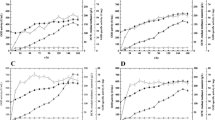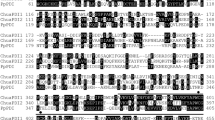Abstract
In recombinant Pichia pastoris fermentation for hirudin production in a 5 l fermenter, a new strategy was explored to match the short fermentation time at low NH4 + concentration with decreased hirudin degradation at high NH4 + concentration. A combination of a defined medium containing initial 0.025 m NH4 + with NH4 + addition up to 0.6 m in the growth phase was achieved in both the improvement of hirudin production and the repression of hirudin degradation. Intact and total hirudin reached 2.63 g l−1 and 4.25 g l−1, respectively.
Similar content being viewed by others
References
Alain VD, Pierre L, Francis B, Odile W, Nadine RB, Daniel F, Brian G, Carolyn R (1989) Mass spectrometry analyses of recombinant hirudins (7 kDa). Biochemistry 28: 2949–2956.
Heim J, Takabayashi K, Meyhack B, Marki W, Pohlig G (1994) C-Terminal proteolytic degradation of recombinant desulfatohirudin and its mutants in the yeast Saccharomyces cerevisiae. Eur. J. Biochem. 226: 341–353.
Kim CH, Sohn JH, Choi ES, Rhee SK (1996) Effect of soybean oil on the enhanced expression of hirudin gene in Hansenula polymorpha. Biotechnol. Lett. 18: 417–422.
Lehman E, Joyce G, Bailey F, Markus Z, Schultz D, Dunwiddie T, Jacobson A, Miller J (1993) Expression, purification and characterization of multigram amounts of a recombinant hybrid HV1-HV2 hirudin variant expressed in Saccharomyces cerevisiae. Protein Expr. Purif. 4: 247–255.
Rao KJ, Kim CH, Chung BH, Kim MK, Rhee SK (1999) Suppression of proteolytic degradation of recombinant hirudin from Saccharomyces cerevisiae using the O2-enriched air. Biotechnol. Lett. 21: 391–394.
Riehl-Bellon N, Dorothee C, Michele A, Alain VD, Magda M, Gerard L, Yves L, Stephen WB, Michael C, Carolyn R (1989) Purification and biochemical characterization of recombinant hirudin produced by Saccharomyces cerevisiae. Biochemistry 28: 2941–2949.
Rosenfeld SA, Nadeau D, Tirado J, Hollis GF, Knabb RM, Jia S (1996) Production and purification of recombinant hirudin expression in the methylotrophic yeast Pichia pastoris. Protein Exp. Purif. 8: 476–482.
Sohn JH, Kang HA, Rao KJ, Kim CH, Choi ES, Chung BH, Rhee SK (2001) Current status of the anticoagulant hirudin: its biotechnological production and clinical practice. Appl. Microbiol. Biotechnol. 55: 606–613.
Weydemann U, Keup P, Piontek M, Strasser AW, Schweden J, Gellissen G, Janowicz ZA (1995) High-level secretion of hirudin by Hansenula polymorpha authentic processing of three different preprohirudins. Appl. Microbiol. Biotechnol. 44: 377–385.
Zhou X-S, Zhang Y-X (2002) Decrease of proteolytic degradation of recombinant hirudin produced by Pichia pastoris by controlling the specific growth rate. Biotechnol. Lett. 24: 1449–1453.
Author information
Authors and Affiliations
Rights and permissions
About this article
Cite this article
Yang, J., Zhou, X. & Zhang, Y. Improvement of recombinant hirudin production by controlling NH4 + concentration in Pichia pastoris fermentation. Biotechnology Letters 26, 1013–1017 (2004). https://doi.org/10.1023/B:BILE.0000030049.75092.95
Issue Date:
DOI: https://doi.org/10.1023/B:BILE.0000030049.75092.95




